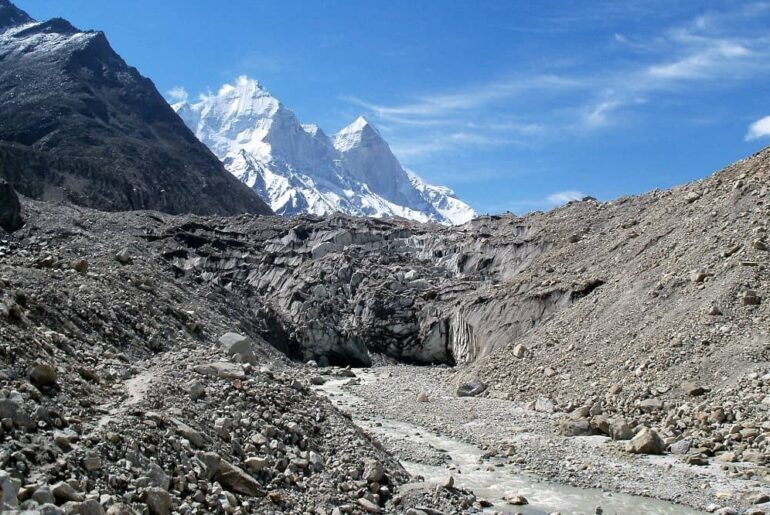Discover the Source of the Ganges and Trekking Route distance
The Ganges River, also known as the Ganga in Hindi and other Indian languages, the The Source of the Ganges is known as Gaumukh. It is a significant river in the northern Indian subcontinent. It has been revered as a sacred river in Hinduism since ancient times.
- The river flows through a highly fertile and densely populated region, mostly as a wide and slow-moving stream. Although relatively shorter compared to other major rivers in Asia and the world, it stretches for 1,560 miles (2,510 km).
- Originating in the Himalayas and eventually emptying into the Bay of Bengal, the Ganges River drains a quarter of India’s territory and supports hundreds of millions of people in its basin.
- The Indo-Gangetic Plain, through which the river flows, is the heartland of Hindustan and has been the birthplace of various civilizations, from the Mauryan empire of Ashoka in the 3rd century BCE to the Mughal Empire, established in the 16th century.
- While the majority of the Ganges flows through Indian territory, its extensive delta in the Bengal region, shared with the Brahmaputra River, primarily lies in Bangladesh. The river generally flows in a northwest-to-southeast direction, turning southward at its delta.
The Sacred Source of the Ganga River
The Ganges River begins its journey in the southern Great Himalayas on the Indian side of the border with the Tibet Autonomous Region of China. It is formed by five headstreams: the Bhagirathi, the Alaknanda, the Mandakini, the Dhauliganga, and the Pindar.
These headstreams originate in the mountainous region of northern Uttarakhand state in India. The Alaknanda, which is the longer of the two main headstreams, starts about 30 miles (50 km) north of the Himalayan peak called Nanda Devi.
The Bhagirathi, on the other hand, begins at an elevation of about 10,000 feet (3,000 meters) above sea level in a subglacial meltwater cave located at the base of the Gangotri glacier, a well-known site for Hindu pilgrims.
However, the actual source of the Ganges is considered to be Gaumukh, situated about 12 miles (1 8 km) southeast of Gangotri.
Suggested Read- Bhojwasa: Last Point to Stay at Gaumukh

Trekking to Gaumukh:
To reach Gaumukh ( The Source of the Ganges) , one must embark on a trekking expedition that starts from Gangotri, a small town nestled in the Garhwal Himalayas.
The trek takes you through picturesque landscapes, dense forests, and meadows, offering glimpses of the snow-clad peaks that surround the region. The trek is moderate to difficult and typically takes around 6-8 days round trip, so it’s important to be prepared and physically fit.
Devprayag:
At Devaprayag, the Alaknanda and Bhagirathi rivers come together and form the primary stream called the Ganga. From there, the Ganga River flows southwestward through the Siwalik Range, which is the Outer Himalayas, located at the northern boundary of the Indo-Gangetic Plain.
- It emerges from the mountains at Rishikesh. Subsequently, it reaches the plain at Haridwar, which is another significant sacred site for Hindus.
- The Ganges River enters Bihar, where it receives its main tributaries from the Himalayan region of Nepal: the Gandak, Burhi Gandak, Ghugri, and Kosi rivers.
- The Son River is its significant southern tributary. Moving southeast, it skirts the Rajmahal Hills and reaches Farakka in central West Bengal. In West Bengal and Bangladesh, the Ganges is locally known as the Padma.
- In West Bengal, it is joined by the Mahananda River, and its westernmost distributaries are the Bhagirathi and Hugli (Hooghly) rivers, near Kolkata. As it enters Bangladesh, it meets the Brahmaputra (Jamuna) near Goalundo Ghat.
- The combined stream called the Padma, merges with the Meghna River above Chandpur, and the waters flow through the delta region into the Bay of Bengal via numerous channels, including the Meghna estuary.
Suggested Read- Best Time to visit Source of Ganges- A Travel Guide

Gaumukh:
Upon reaching Gaumukh ( The Source of the Ganges), you’ll witness a breathtaking sight. The source of the Ganges emerges from the glacial snout, resembling the open mouth of a cow. The pristine waters flow gracefully from the mighty Gangotri Glacier, one of the largest in the Himalayan region.
Explore Gaumukh:
While at Gaumukh ( The Source of the Ganges), take time to explore the serene surroundings. Surrounded by snow-capped peaks and breathtaking vistas, the landscape provides a perfect setting for meditation and self-reflection. You may also encounter Himalayan wildlife, such as Bharal (blue sheep), Himalayan Thar, and various bird species.
Suggested Read- Gangotri to Gaumukh- A details write-up

Gaumukh ( The Source of the Ganges) to Tapovan:
For a deeper spiritual experience, you can trek further from Gaumukh to Tapovan, a high-altitude meadow at around 4,463 meters. Tapovan is the abode of Lord Shiva according to Hindu mythology. The majestic peaks of Shivling and Meru surround this enchanting location, making it a remarkable spot for meditation and yoga enthusiasts.
Conclusion:
The Source of the Ganges is a transformative journey that combines adventure, spirituality, and natural beauty. As you traverse the rugged terrains will emerge this sacred river. You’ll feel the mystical energy that permeates the region. The experience will leave an indelible mark on your soul, fostering a deeper understanding of India’s cultural and spiritual heritage.




Comments are closed.